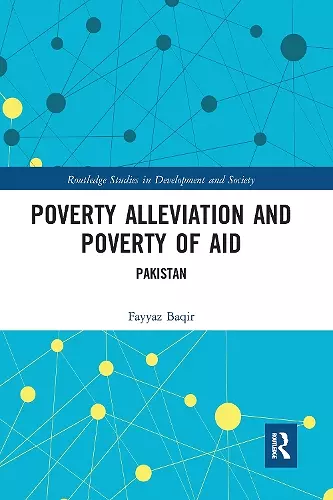Poverty Alleviation and Poverty of Aid
Pakistan
Format:Paperback
Publisher:Taylor & Francis Ltd
Published:30th Jun '20
Currently unavailable, and unfortunately no date known when it will be back
This paperback is available in another edition too:
- Hardback£145.00(9781138480988)

Aid effectiveness has emerged as an intensely debated issue amongst policy makers, donors, development practitioners, civil society and academics during the past decade. This debate revolves around one important question: does official development assistance complement, duplicate or disregard the local resource endowment in offering support to recipient economies?
This book draws on Pakistan’s experience in responding to this question with a diverse range of examples. It focuses on a central idea: no aid effectiveness without an effective receiving mechanism. Pakistan is among the top aid recipient countries in the developing economies. It was a shining model in the sixties and it ranks among the highly underperforming countries after the new millennium. This book offers an insight into the dynamics of success and failure of Pakistan in availing foreign financial and technical assistance for human development and poverty alleviation. It draws on field experiences to present case studies on water, shelter, health, education, and health and safety at work to identify the causes and consequences of aid in relation to social reality. Findings relate to developing economies and would be of interest to a wide range of individuals within the development sector.
‘Fayyaz Baqir’s book, Poverty Alleviation and Poverty of Aid, offers a brilliant exposure of how international assistance operated in Pakistan; and how the measures undertaken for poverty reduction fell short of addressing the major issues that needed attention. Using stories of development and historical and conceptual analyses, Fayyaz provides a rich account of how Pakistan’s key problem has not been lack of financial resources but of efficient and effective use of the resources’ — Nipa Banerjee, Senior Fellow, School of International Development & Center for International Policy Studies, University of Ottawa Sprott School of Business- Carleton University, Senior Advisor, Rideau Institute
'This book is fascinating. The examples are so clear and detailed and heartbreaking . Everyone in the development field should read it. The examples of what has been effective and what hasn't are concrete and well-supported. I look forward to the next book by this author examining examples of effective programs from several countries.'— Barbara Neuwelt, former volunteer, CUSO, Canada
"I found your insights into what makes effective development both powerful and well documented. I fully agree that development works best when it is organically designed bottom-up with local communities and that very little seed money from international aid agencies is needed, and in fact can weaken ownership and sustainability and add to the debt burden. I also have found that farmers and the poor can pay (and indeed as you point out, often pay more than others informally) for services if they are given ownership and responsibility. I thought your description of the "business" of aid on page 30 was chillingly accurate [..] Twenty years ago, based on strong evidence that local ownership was of critical importance, the World Bank began moving away from the "Washington Consensus" to listening harder to clients, recognizing the need for inclusive and differentiated national strategies." — Anthony Cholst, World Bank’s Former Operations Adviser, Pakistan
‘Fayyaz Baqir’s book, Poverty Alleviation and Poverty of Aid, offers a brilliant exposure of how international assistance operated in Pakistan; and how the measures undertaken for poverty reduction fell short of addressing the major issues that needed attention. Using stories of development and historical and conceptual analyses, Fayyaz provides a rich account of how Pakistan’s key problem has not been lack of financial resources but of efficient and effective use of the resources’ — Nipa Banerjee, Senior Fellow, School of International Development & Center for International Policy Studies, University of Ottawa Sprott School of Business- Carleton University, Senior Advisor, Rideau Institute
'This book is fascinating. The examples are so clear and detailed and heartbreaking . Everyone in the development field should read it. The examples of what has been effective and what hasn't are concrete and well-supported. I look forward to the next book by this author examining examples of effective programs from several countries.'— Barbara Neuwelt, former volunteer, CUSO, Canada
"I found your insights into what makes effective development both powerful and well documented. I fully agree that development works best when it is organically designed bottom-up with local communities and that very little seed money from international aid agencies is needed, and in fact can weaken ownership and sustainability and add to the debt burden. I also have found that farmers and the poor can pay (and indeed as you point out, often pay more than others informally) for services if they are given ownership and responsibility. I thought your description of the "business" of aid on page 30 was chillingly accurate [..] Twenty years ago, based on strong evidence that local ownership was of critical importance, the World Bank began moving away from the "Washington Consensus" to listening harder to clients, recognizing the need for inclusive and differentiated national strategies." — Anthony Cholst, World Bank’s Former Operations Adviser, Pakistan
ISBN: 9780367587826
Dimensions: unknown
Weight: 453g
158 pages